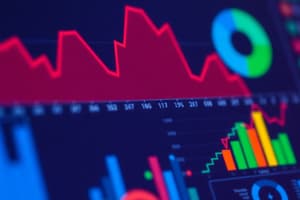Podcast
Questions and Answers
What is a trend primarily used for?
What is a trend primarily used for?
- Determining individual data points
- Simple observation of data
- Forecasts and predictions (correct)
- Drawing conclusions from random data
A trend can be inferred from just two data points.
A trend can be inferred from just two data points.
False (B)
What must be done before declaring a no change as a trend?
What must be done before declaring a no change as a trend?
A statistical test must be performed.
A _______ trend is characterized by a continuous decrease or increase in numbers over time.
A _______ trend is characterized by a continuous decrease or increase in numbers over time.
Match the rules to their descriptions regarding trends:
Match the rules to their descriptions regarding trends:
What is the primary purpose of using a trendline in data analysis?
What is the primary purpose of using a trendline in data analysis?
A trendline is reliable when its R-squared value is 0%.
A trendline is reliable when its R-squared value is 0%.
What does an R-squared value of 100% indicate?
What does an R-squared value of 100% indicate?
The larger the R-squared value, the better the _______ model fits our observations.
The larger the R-squared value, the better the _______ model fits our observations.
Cyclical patterns in data are characterized by:
Cyclical patterns in data are characterized by:
A stationary series systematically increases over time.
A stationary series systematically increases over time.
What is a common goal when drawing a trendline in a scatter plot?
What is a common goal when drawing a trendline in a scatter plot?
Match the terms related to trendlines with their corresponding descriptions:
Match the terms related to trendlines with their corresponding descriptions:
What type of trend appears as a straight line on a graph?
What type of trend appears as a straight line on a graph?
An exponential trend produces straight lines on a graph.
An exponential trend produces straight lines on a graph.
What is the visual characteristic of an upward linear trend on a graph?
What is the visual characteristic of an upward linear trend on a graph?
In an exponential trend, the data rises or falls at a ________ rate.
In an exponential trend, the data rises or falls at a ________ rate.
Which of the following illustrates a situation where the last data point is higher than the first in an upward trend?
Which of the following illustrates a situation where the last data point is higher than the first in an upward trend?
Match the following definitions with their corresponding trend types:
Match the following definitions with their corresponding trend types:
A downward trend results in the last data point being higher than the first.
A downward trend results in the last data point being higher than the first.
What indicates the steepness or shallowness of a linear trend line?
What indicates the steepness or shallowness of a linear trend line?
Flashcards
Trend
Trend
A pattern that describes a gradual increase or decrease in data over a long period, usually several years.
Linear Trend
Linear Trend
The data points change in a straight line, either upward or downward.
Two Points don't make a trend
Two Points don't make a trend
Two data points are not enough to identify a trend. You need multiple data points to see if there's a consistent pattern.
Cherry-Picking Data
Cherry-Picking Data
Don't just pick the years that support your idea. A trend must be consistent over a longer period.
Signup and view all the flashcards
Trend Line needs statistics
Trend Line needs statistics
A simple line drawn between the first and last data points is not a true trend. You need statistical methods to estimate the trend accurately.
Signup and view all the flashcards
Exponential Trend
Exponential Trend
A type of trend where data points on a graph form a curved line, indicating a faster rate of increase or decrease over time.
Signup and view all the flashcards
Trend Analysis
Trend Analysis
A statistical technique used to analyze trends that can be displayed on a graph.
Signup and view all the flashcards
Trend Direction
Trend Direction
The direction of a trend can be either upward or downward, representing an increase or decrease in the data over time.
Signup and view all the flashcards
Linear Trend Rate of Change
Linear Trend Rate of Change
In a linear trend, the rate of change is consistent, meaning the data increases or decreases at a steady pace.
Signup and view all the flashcards
Exponential Trend Rate of Change
Exponential Trend Rate of Change
In an exponential trend, the rate of change accelerates over time, resulting in a faster increase or decrease in later periods.
Signup and view all the flashcards
Trend on a Graph
Trend on a Graph
A trend on a graph is a visual representation of data points over time.
Signup and view all the flashcards
Importance of Trend Analysis
Importance of Trend Analysis
Understanding trends helps analyze data, forecast future outcomes, and make informed decisions based on patterns in the data.
Signup and view all the flashcards
Stationary Series
Stationary Series
A stationary series that fluctuates around a constant mean level over time, with constant variance. It neither decreases nor increases systematically.
Signup and view all the flashcards
Seasonal Patterns
Seasonal Patterns
Data that fluctuates in a predictable pattern over time, with a fixed period of repetition.
Signup and view all the flashcards
Cyclical Patterns
Cyclical Patterns
Data that fluctuates in a non-predictable pattern, extending beyond a year. These patterns are unpredictable and don't repeat over fixed periods.
Signup and view all the flashcards
Trendline
Trendline
A line that represents the best fit for a set of data points, summarizing the relationship between two variables and how one changes as the other changes.
Signup and view all the flashcards
R-squared Value
R-squared Value
The value indicating the percentage of variance in the dependent variable explained by the independent variable. It essentially measures how well the trendline fits the data points.
Signup and view all the flashcards
R-squared Value of 0%
R-squared Value of 0%
A model that fails to account for any variation in the dependent variable around its average value.
Signup and view all the flashcards
R-squared Value of 100%
R-squared Value of 100%
A model that perfectly explains all the variation in the dependent variable around its average value.
Signup and view all the flashcards
R-squared Rule of Thumb
R-squared Rule of Thumb
A general guideline that suggests aiming for an R-squared value of at least 80% or higher to indicate a good fit between a regression model and the data.
Signup and view all the flashcardsStudy Notes
Data Analytics for Business Optimization Final Exam
- Regression Analysis Goal: Model relationships between one or more independent variables and a dependent variable, predicting future outcomes or trends.
Inferential Statistics
- Decision Making: Used in reaching conclusions beyond immediate data, generalizing from samples to populations.
- Hypothesis Testing: Involves probability and testing hypotheses.
- Decisions: Making choices based on analyzed data.
Independent and Dependent Variables
- Independent Variable (X): Variable manipulated or controlled, used to explain or predict changes in the dependent variable. Synonyms include predictors, factors, and explanatory variables.
- Dependent Variable (Y): Variable whose value is affected by independent variables, what the model aims to explain or predict. Synonyms include response variable.
Types of Variables
- Independent: Time spent sleeping before an exam (predictor)
- Dependent: Test score (outcome)
- Independent: Consumption of fast food
- Dependent: Blood pressure
- Independent: Amount of caffeine consumed
- Dependent: Sleep
Inferential Statistics Work
- Relationship: If there's a relationship between two variables, one variable's value can predict the other.
- Correlation vs. Regression: Correlation assesses the relationship, regression models how one affects the other.
- Strong Relationship: Variables move in tandem, appear related. Statistical correlation doesn't prove causation.
- Correlation does not imply causation.
Rules: Correlation vs. Causation
- Apparent similarities in fluctuation don't prove meaningful relationships.
- Fluctuations could be due to random chance (variables may appear related but are not), or a third, lurking variable could influence the relationship.
What is a Trend?
- A pattern in time series data showing upward or downward movement.
- Trends guide forecasting, predictions, and planning.
Rules for Trends
- Two data points don't define a trend.
- Convenient start/end points can misrepresent a trend.
- A trend line drawn between the first and last data points isn't completely accurate, needs statistical techniques.
- No change is not a trend until statistically tested.
Types of Trends
- Linear: Continuous increasing/decreasing across time (straight line on a graph)
- Exponential: Data increases/decreases at an accelerating rate (curved line).
- Seasonality: Fluctuations that repeat over fixed periods (e.g., holidays, weather). Highly predictable.
- Irregular/Random: Unpredictable fluctuations.
- Cyclical: Fluctuations that don't repeat over fixed periods (longer than one year)
Time Series Analysis
- Forecasting: Predicting future observation values based on past information.
- Time series: A sequence of data points observed at regular time intervals.
Regression Analysis
- Method: Quantifies the relationship between two or more variables, to assess influence, predict future outcomes, and optimize related processes. Includes simple linear (one independent variable) and multiple linear (two or more independent variables). Essential for forecasting.
- R-squared: Measures how well the regression model fits the data.
- Correlation vs. Regression: Correlation assesses the relationship, while regression models the effect of one variable on another.
Types of Hypothesis
- Null hypothesis: There is no effect or relationship between variables.
- Alternative hypothesis: There is an effect or a relationship between variables.
- Significance: If the F-value (in ANOVA analysis) is low (e.g., less than 0.05) then the hypothesis is significant and probably a better predictor of outcome than another variable.
Forecasting
- Past data: Used for predictions, forecasting future values.
- Time series: Consists of observation data points at an even rate. Usually used for short term forecasting as past trends can be reliable for a limited window.
Other Concepts for Study
- Correlation: Measures the linear association between two variables. Includes covariation (how two variables vary in relation to each other). Shows relationship, not direction of causation.
- Coefficient of Variation: Measures the extent of variability in relation to the population mean of data.
- Multicollinearity: Statistical phenomenon where two or more independent variables are highly correlated.
- Reliability of Data: Important for evaluating the quality and accuracy of data used in models. Use metrics like coefficient of variation to evaluate data variability.
Studying That Suits You
Use AI to generate personalized quizzes and flashcards to suit your learning preferences.




